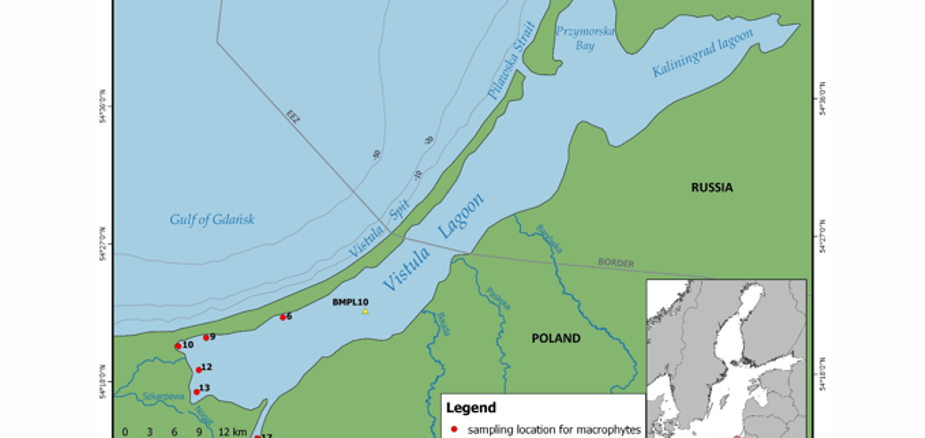
Paper category: Original research paper
Corresponding author: Tamara Zalewska (tamara.zalewska@imgw.pl)
DOI: 10.1515/ohs-2020-0007
Received: 11/07/2019
Accepted: 13/09/2019
Full text: here
Citation (APA style): Zalewska, T., Brzeska-Roszczyk, P., Danowska, B., et al. (2020). Heavy metals and 137Cs levels in macrophytes and temporal distribution in sediments – application for estuarine environment status assessment (Vistula Lagoon – southern Baltic). Oceanological and Hydrobiological Studies, 49(1), pp. 68-80. Retrieved 10 Mar. 2020, from doi:10.1515/ohs-2020-0007
Abstract
References
Alquezar, R., Glendenning, L. & Costanzo, S. (2013). The use of the brown macroalgae, Sargassum flavicans, as a potential bioindicator of industrial nutrient enrichment. Mar. Pollut. Bull. 77: 140–146.
Appleby, P.G. (1997). Dating of sediments by 210Pb: problems and solutions. In Proc of a Seminar Dating of Sediments and Determination of Sedimentation Rate. Helsinki, Finland. STUK A145:7.
Appleby, P.G. & Oldfield, F. (1992). Application of 210Pb to sedimentation studies. In M. Ivanovich & R.S. Harmon (Eds.), Uranium-series Disequilibrium: Application to Earth, Marine and Environmental Sciences. (pp. 731–778). Clarendon Press, Oxford, UK.
Bäck, S. (1999). Guidelines for monitoring of phytobenthic plant and animal communities in the Baltic Sea. Annex C-9. In Manual for Marine Monitoring in the COMBINE Programme of HELCOM. BSEP No. 148.
Boer, W., van den Bergh, G.D, de Haas, H., de Stigter, H.C., Gieles, R. et al. (2006). Validation of accumulation rates in Teluk Banten (Indonesia) from commonly applied 210Pb models, using the 1883 Krakatau tephra as time marker. Mar. Geol. 227: 263–277.
Bojanowski, R. (1973). The occurrence of major and minor chemical elements in the more common Baltic seaweed. Oceanologia 2: 81–152.
Brzeska, P., Woźniczka, A., Pełechaty, M. & Blindow, I. (2015). New records of Chara connivens P. Salzmann ex A. Braun 1835 – an extremely rare and protected species in Polish brackish waters. Acta. Soc. Bot. Pol. 84(1): 143–146. DOI: 10.5586/asbp.2015.010.
Burger, J. (2006). Bioindicators: a review of their use in the environmental literature 1970– 2005. Environ. Bioindicators 1: 136–144.
Chakraborty, S., Bhattacharya, T., Singh, G. & Maity, J.P. (2014). Benthic macroalgae as biological indicators of heavy metal pollution in the marine environments: A biomonitoring approach for pollution assessment. Ecotoxic Environ. Saf. 100: 61–68.
Chubarenko, B. & Margoński, P. (2008). The Vistula Lagoon. In U. Schiewer (Ed.), Ecology of Baltic Coastal Waters Series. Ecol. Stud. Vol. 197, Springer, Berlin: 167–195. DOI: 10.1007/978-3-540-73524-3
Diaz-Asencio, M., Alonso-Hernandez, C.M., Bolanos-Alvarez, Y., Gomez-Batista, M., Pinto, V., et al. (2009). One century sedimentary record of Hg and Pb pollution in the Sagua estuary (Cuba) derived from 210Pb and 137Cs chronology. Mar. Pollut. Bull. 59: 108–115.
Farias, D.R., Hurd, C.L., Eriksen, R.S. & Macleod, C.K. (2018). Macrophytes as bioindicators of heavy metal pollution in estuarine and coastal environment. Mar. Pollut. Bull. 128: 175–184.
Glasby, G.P. & Szefer, P. (1998). Marine pollution in Gdansk Bay, Puck Bay and the Vistula Lagoon, Poland: An overview. Sci. Total. Environ. 212: 49–57.
Haroon, A.M. & Szaniawska, A. (1995). Changes in heavy metal accumulation in Enteromorpha spp. from the Gulf of Gdańsk. Oceanologia 37: 99–110.
HELCOM (2016). Ecological coherence assessment of the Marine Protected Area network in the Baltic.
IAEA (2004). Sediment distribution coefficients and concentration factors for biota in the marine environment. Technical Reports Series No. 422, IAEA, Vienna.
IAEA (2013). Worldwide Laboratory Comparison on the Determination of Radionuclides in IAEA-446 Baltic Sea Seaweed (Fucus vesiculosus). IAEA Analytical Quality in Nuclear Applications Series No. 25. IAEA, Vienna.
IAEA (2014). Handbook of parameter values for the prediction of radionuclide transfer to wildlife. Technical Reports Series No. 479, IAEA, Vienna.
Kruk-Dowgiałło, L., Brzeska, P., Opioła, R. & Kuliński, M. (2010). Makroglony i okrytozalążkowe. In Przewodniki metodyczne do badań terenowych i analiz laboratoryjnych elementów biologicznych wód przejściowych i przybrzeżnych (pp. 33–63). Biblioteka Monitoringu Środowiska, Warszawa. (In Polish).
Kruk-Dowgiałło, L. & Pempkowiak, J. (1995). Macrophytes as indicator of heavy metal contamination in the Puck Lagoon (southern Baltic). In Proceedings of the 14th Baltic Marine Biologists Symposium: Biodiversity in the Baltic ecosystems. Littoral processes, Anaerobic processes. Pärnu, Estonia.
Leal, M.C.F., Vasconcelos, M.T., Sousa-Pinto, I. & Cabral, J.P.S. (1997). Biomonitoring with benthic macroalgae and direct assay of heavy metals in seawater of the Oporto coast (northwest Portugal). Mar. Pollut. Bull. 34: 1006–1015.
Malea, P. & Haritonidis, S. (2000). Use of the green alga Ulva rigida C. Agardh as an indicator species to reassess metal pollution in the Thermaikos Gulf, Greece, after 13 years. J. Appl. Phycol. 12: 169–176.
Ostapczuk, P., Burow, M., May, K., Mohl, C., Froning, M. et al. (1997). Mussels and algae as bioindicators for long-term tendencies of element pollution in marine ecosystems. Chemosphere 34: 2049–2058.
Pham, M.K., Benmansour, M., Carvalho, F.P., Chamizo, E., Degering, D. et al. (2014). Certified Reference Material IAEA-446 for radionuclides in Baltic Sea seaweed. Appl. Radiat. Isot. 87: 468–474.
Pliński, M. (1995). Vascular plants of the northern part of the Vistula Lagoon. Bull. Mar. Inst. 22: 81–87.
Pliński, M., Kreńska, B. & Wnorowski, T. (1978). Stosunki florystyczne i biomasa roślinności naczyniowej Zalewu Wiślanego. In Biologia Morza (4). Zalew Wiślany. Zmiany w biocenozach pod wpływem presji antropogennych. SiMO 21: 161–196.
Rainbow, P.S. (1995). Biomonitoring of heavy metal availability in the marine environment. Mar. Pollut. Bull. 31: 183–192.
Sawidis, T., Heinrich, G. & Brown, M.-T. (2003). Cesium-137 concentrations in marine macroalgae from different biotopes in the Aegean Sea (Greece). Ecotoxic. Environ. Saf. 54: 249–254.
Sinaei, M., Loghmani, M. & Bolouki, M. (2018). Application of biomarkers in brown algae (Cystoseria indica) to assess heavy metals (Cd, Cu, Zn, Pb, Hg, Ni, Cr) pollution in the northern coasts of the Gulf of Oman. Ecotoxic. Environ. Saf. 164: 675–680.
Szefer, P. (2002a). Metals, metalloids, and radionuclides in the Baltic Sea ecosystem. Elsevier, Amsterdam; New York.
Szefer, P. (2002b). Metal pollutants and radionuclides in the Baltic Sea – an overview. Oceanologia 44(2): 129–178.
Szefer P., Glasby, G.P., Stüben, D., Kusak, A., Geldon, J. et al. (1999). Distribution of selected heavy metals and rare earth elements in surficial sediments from the Polish sector of the Vistula Lagoon. Chemosphere 39: 2785–2798.
Szefer, P. & Skwarzec, B. (1988). Concentration of elements in some seaweeds from coastal region of the southern Baltic and the Żarnowieckie Lake. Oceanologia 25: 87–98.
Szmytkiewicz, A. & Zalewska, T. (2014). Sediment deposition and accumulation rates determined by sediment trap 210Pb isotope methods in the Outer Puck Bay (Baltic Sea), Oceanologia 56(1): 85–106.
Urbaniak, J. (2010). Estimation of carbonate and element content in charophytes – methods of determination. Pol. J. Environ. Stud. 19(2): 413–417.
Zalewska, T. (2012a). Seasonal changes of 137Cs in benthic plants from the southern Baltic Sea. J. Radioanal. Nucl. Chem. 292: 211–218.
Zalewska, T. (2012b). Distribution of 137Cs in benthic plants along depth profiles in the outer Puck Bay (Baltic Sea). J. Radioanal. Nucl. Chem. 293: 679–688.
Zalewska, T. (2015). Bioindyktory makrofitobentosowe w ocenie stanu środowiska południowego Bałtyku. ISBN 978-83-64979-07-1, IMGW – PIB. Warszawa.
Zalewska, T. & Danowska, B. (2017). Marine environment status assessment based on macrophytobenthic plants as bio-indicators of heavy metals pollution. Mar. Pollut. Bull. 118(1–2): 281–288.
Zalewska, T. & Saniewski, M. (2011). Bioaccumulation of 137Cs by benthic plants and macroinvertebrates. Oceanol. Hydrobiol. St. 40(3): 1–8.
Zalewska, T. & Suplińska, M. (2012). Reference organisms for assessing the impact of ionizing radiation on the environment of the southern Baltic Sea. Oceanol. Hydrobiol. St. 41(4): 1–7.
Zalewska, T., Woroń, J., Danowska, B. & Suplińska, M. (2015). Temporal changes in Hg, Pb, Cd and Zn environmental concentrations in the southern Baltic Sea sediments dated with 210Pb method. Oceanologia 57(1): 32–43.
Żbikowski, R., Szefer, P. & Latała, A. (2007). Comparison of green algae Cladophora sp. and Enteromorpha sp. as potential biomonitors of chemical elements in the southern Baltic. Sci. Total Environ. 387: 320–332.




Bądź pierwszy, który skomentuje ten wpis